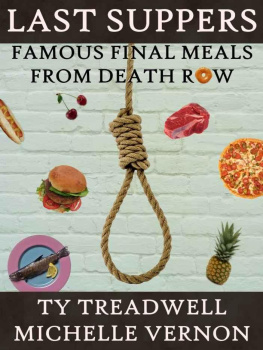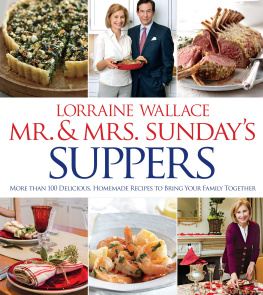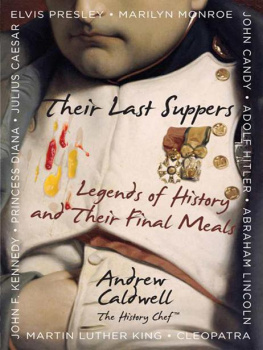Treadwell Ty - Last Suppers: Famous Final Meals from Death Row
Here you can read online Treadwell Ty - Last Suppers: Famous Final Meals from Death Row full text of the book (entire story) in english for free. Download pdf and epub, get meaning, cover and reviews about this ebook. year: 2011, genre: Detective and thriller. Description of the work, (preface) as well as reviews are available. Best literature library LitArk.com created for fans of good reading and offers a wide selection of genres:
Romance novel
Science fiction
Adventure
Detective
Science
History
Home and family
Prose
Art
Politics
Computer
Non-fiction
Religion
Business
Children
Humor
Choose a favorite category and find really read worthwhile books. Enjoy immersion in the world of imagination, feel the emotions of the characters or learn something new for yourself, make an fascinating discovery.
- Book:Last Suppers: Famous Final Meals from Death Row
- Author:
- Genre:
- Year:2011
- Rating:5 / 5
- Favourites:Add to favourites
- Your mark:
- 100
- 1
- 2
- 3
- 4
- 5
Last Suppers: Famous Final Meals from Death Row: summary, description and annotation
We offer to read an annotation, description, summary or preface (depends on what the author of the book "Last Suppers: Famous Final Meals from Death Row" wrote himself). If you haven't found the necessary information about the book — write in the comments, we will try to find it.
Last Suppers: Famous Final Meals from Death Row — read online for free the complete book (whole text) full work
Below is the text of the book, divided by pages. System saving the place of the last page read, allows you to conveniently read the book "Last Suppers: Famous Final Meals from Death Row" online for free, without having to search again every time where you left off. Put a bookmark, and you can go to the page where you finished reading at any time.
Font size:
Interval:
Bookmark:
Last Suppers: Famous Final Meals from Death Row
By Ty Treadwell and Michelle Vernon
Copyright Ty Treadwell and Michelle Vernon
All rights reserved. No part of this book may be reproduced in any form whatsoever without prior written consent from the authors. Reviews may quote brief passages without written consent from the authors as long as proper credit is given.
TABLE OF CONTENTS
Last meals, recipes, weird execution facts, and other morsels of information
are sprinkled throughout the book for your dining pleasure
The Ungrateful Dead: Capital Punishment in America
Once upon a time, execution was considered socially acceptable as a deterrent to all types of social transgressions. Not only murder, but crimes such as adultery, blasphemy, and even non-conformism were once considered heinous enough to warrant a death sentence. In one instance, the suspected theft of a queens hairbrush was sufficient grounds for a trip to the gallows. These days, however, kleptomaniacs and other petty crooks can rest easy at night since execution is now reserved only for the most serious of crimes, with the United States remaining one of the few civilized nations to utilize capital punishment as a crime-fighting tool.
In 1972 the Supreme Court declared the death penalty unconstitutional, deeming it both arbitrary and discriminatory, and therefore violating the Eighth Amendment, which prohibits "cruel and unusual punishment." During the confusing four-year hiatus, many state statutes were hastily rewritten to abide by the new Supreme Court standards. As the revamped statutes met with judicial approval, the death penalty was slowly reintroduced on a state-by-state basis. Capital punishment is now legal in 34 states; every state has at least one death row resident, and California leads the pack with a whopping 704.
Since the return of the death penalty in 1976, over 1200 executions have been carried out across the United States. Texas---where everything is bigger---has performed the most executions (466), followed by Virginia, Oklahoma, and Florida. There are currently over 3000 inmates on Death Row, with each one spending an average of ten years in jail waiting for their sentence to be carried out.
For the condemned man, execution is sometimes seen as a welcome alternative to a life behind bars. Many executed felons have voluntarily abandoned the appeals process and have requested that their death sentence be carried out ASAP. The individual reasons for hastening their date with death vary greatly; maybe its the thought of being permanently confined with a roomie like Charles Manson, or the prospect of having to shovel down three bland, tasteless prison meals per day while trying to keep a 300-pound fellow inmate from stealing your dessert. A few prisoners, such as Ricky Lee Sanderson, have chosen death as a grand gesture of supposed remorse for their crimes. Others may simply get a kick out of manipulating the legal system, as is often suggested in reports of the nations most famous volunteer, Gary Gilmore.
No Noose is Good Noose: Trends in Execution Methods
Capital punishment is currently reserved for the worst of the worst, the rancid cream of the criminal crop. Rarely is a simple murder considered sufficient grounds for a death sentence. Most are brutal, violent crimes which include murder with other aggravating factors such as torture, rape, or robbery. For example, a man will not receive a death sentence for stabbing a woman 40 times, but he can be executed if he stabs her 40 times and also steals her purse. Most Death Row inmates have a long list of "priors" for other violent crimes, which sometimes include prior murder convictions. Others have committed their capital offenses while incarcerated, or while on work release from prison.
While the average criminal's methods of murder seem to get more and more violent, the execution procedures favored by the state have gone in the opposite direction. These days a crazed hammer-wielding killer is likely to receive a far more peaceful sendoff than his victim. This has not, however, always been the case.
In earlier days, the execution of a criminal was often far more gruesome than the crime itself. Many countries showed an incredible display of creativity in designing methods of torture and death to punish unlucky transgressors of their social order. Christian martyrs in Europe were drowned, stoned, or burned at the stake. Ancient Chinese would secure the criminal in a wooden frame and saw him in half using a two-man bow saw. In medieval England, the executioner would pour molten iron down the prisoners throat and burn him to death from the inside-out, or they could burn him from the outside-in by placing him on a gridiron over a fire to create a human barbecue. The French were quite fond of the grisly height-altering device called the guillotine, and in the Middle East the authorities had no hang-ups whatsoever about sentencing criminals to the punishment used in history's most famous execution---crucifixion.
America has enjoyed a long tradition of hanging those convicted of capital crimes. While many of these executions were carried out without a hitch, there were also numerous reports from the late 1800s of botched hangings so gruesome that they left witnesses horrified. Sometimes a blunder involving the length or strength of a rope required the prisoner to be hanged more than once, or an improperly-tied noose could leave the condemned man twisting and turning for half an hour before he finally choked to death. Although hangings were popular events which drew huge crowds, an occasional error on the executioners part was still likely to cause mass disgust. One of the worst examples of this was when the hangmans miscalculation of the drop-distance caused a criminal's head to separate from his body, creating an effect much like the front-row experience at a Blue Man Group performance (but without the complimentary plastic ponchos).
As a result, concerned statesmen began the long search for a more humane and less dramatic technique of doing away with the socially undesirable. Thus the Death Commission was born, headed by the founder of the Society for the Prevention of Cruelty to Children.
The Commission investigated over forty different means of human execution, eventually narrowing the list down to four possible candidates; electrocution, injection of poison, garrote, and guillotine. Following a survey of professionals in the legal, medical, and scientific fields, electrocution won by a narrow margin over the traditional method of hanging, and in1888 New York became the first state to replace the gallows with the electric chair. This method, sometimes called sitting in the sheriffs lap, can be just as grisly as the worst hanging, and the search for a more sanitary instrument of death continued. Several states experimented with the gas chamber, but this method never caught on widely and is rarely used in current times.
The system that has enjoyed overwhelming popularity in recent years is death by lethal injection, currently used in almost every state where capital punishment is legal. This kinder, gentler method more closely resembles a minor medical procedure performed on an outpatient basis, with the one big difference being that this patient never leaves the office alive. Occasionally the condemned man is free to choose the gas chamber, hanging, or death by firing squad as an option, but in most states lethal injection is the sole method in use. Only four states (Alabama, Florida, South Carolina, and Virginia) still offer the electric chair as an alternative.
The Main Course: Why Last Suppers?
Execution rituals have always varied slightly from state to state, not only in the method of execution but also in the care and treatment of the accused during his final hours. The protocol involved in the process is chronicled in ancient execution manuals kept by each state, although many of these texts were written decades ago and are adhered to for tradition only.
Next pageFont size:
Interval:
Bookmark:
Similar books «Last Suppers: Famous Final Meals from Death Row»
Look at similar books to Last Suppers: Famous Final Meals from Death Row. We have selected literature similar in name and meaning in the hope of providing readers with more options to find new, interesting, not yet read works.
Discussion, reviews of the book Last Suppers: Famous Final Meals from Death Row and just readers' own opinions. Leave your comments, write what you think about the work, its meaning or the main characters. Specify what exactly you liked and what you didn't like, and why you think so.











